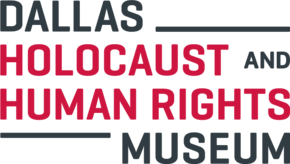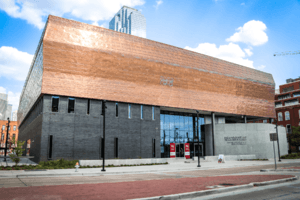Dallas Holocaust and Human Rights Museum facts for kids
The Dallas Holocaust and Human Rights Museum is a special museum in Dallas, Texas. It teaches people about the history of the Holocaust and human rights. Its goal is to help people learn how to fight against prejudice, hatred, and the problem of not caring when others are treated badly.
The museum has archives and a library where people can do research. The building you can visit today opened on September 18, 2019. Its mission is to educate visitors and inspire them to stand up for what is right.
 |
|

Museum Entrance on Houston Street
|
|
| Lua error in Module:Location_map at line 420: attempt to index field 'wikibase' (a nil value). | |
| Former name | Dallas Holocaust Museum Center for Education and Tolerance |
|---|---|
| Established | 1984 |
| Location | 300 N Houston St, Dallas, TX 75202 |
| Type | Holocaust / human rights museum |
| Visitors | +80,000 annually (2018) |
| Architect | Omniplan |
| Public transit access | DART - West End station |
| Nearest car park | 333 N Houston St, Dallas, TX 75202 |
|
Kingman-Texas Building
|
|
|
U.S. Historic district
Contributing property |
|
| Location | 209-211 N. Record St. |
| Built | 1907 |
| Architectural style | Richardsonian Romanesque |
| Part of | West End Historic District (ID78002918) |
| Significant dates | |
| Designated CP | November 14, 1978 |
Contents
History of the Museum
The story of the museum began in 1977. A group of 125 Jewish Holocaust survivors living in Dallas, including a man named Max Glauben, came together. They created an organization to share their stories.
In 1984, this group, with help from other supporters in North Texas, opened the Dallas Memorial Center for Holocaust Studies. It was first located in the Dallas Jewish Community Center. In 2005, the museum moved to a new location in downtown Dallas and changed its name.
Today, the Dallas Holocaust and Human Rights Museum (DHHRM) is in a large, 55,000-square-foot building in the historic West End of Dallas.
What's Inside the Museum?
The museum's main exhibition is divided into four parts, called wings. Each wing tells a different part of the story of the Holocaust and human rights.
The Orientation Wing
Your tour starts here in a small theater. You'll watch a short movie that asks important questions, like "Why should I care about the Holocaust and human rights?" and "What can I do to help?"
After the film, you'll learn about the history of hatred against Jewish people and how it was used by Hitler and the Nazis. You will also see a large photo wall showing the families of Dallas-area survivors before the Holocaust.
The Holocaust / Shoah Wing
This wing teaches the history of the Holocaust, which is also known by the Hebrew word Shoah. It features stories from 68 local survivors and shows nine original films.
A powerful part of this exhibit is a real boxcar from the Nazi era. This was the first time a rail car like this was ever put on display in a museum. Visitors can walk through it to better understand what people experienced. The wing also highlights stories of "Upstanders"—brave people who stood up against the Nazis.
The Human Rights Wing
After learning about the Holocaust, this wing shows how the world tried to protect human rights. It starts with the Universal Declaration of Human Rights, a document that lists the rights every person should have.
You'll learn about the Nuremberg trials, where Nazi leaders were held responsible for their crimes after World War II. There is also a gallery about the Ten Stages of Genocide. It shows how genocides, like the ones in Rwanda and Guatemala, have happened throughout history.
The Pivot to America Wing
This final wing challenges visitors to think about the United States. It explores American ideals, like freedom and equality, and the times when the country has struggled to live up to them.
Interactive screens let you learn about the history of civil rights in America. You'll also discover American "Upstanders" who worked to make the country a better place. The exhibit ends with a "Call to Action," encouraging you to get involved and make a difference.
A Conversation with a Survivor
The museum has a special interactive theater called Dimensions in Testimony. It uses 3D hologram technology and artificial intelligence to let you have a conversation with a survivor of genocide. It feels like they are in the room with you, answering your questions.
One of the featured survivors is Max Glauben, a founder of the museum. In 2018, he was filmed with 360-degree cameras. He was asked over 1,000 questions about his life. He survived the Warsaw Ghetto and was orphaned as a teenager in a concentration camp. Through this technology, his story and memory can be shared for many years to come.
Museum Design and Building
The museum's building was carefully designed. The outside is made of brick to match the historic buildings around it. But it also has a large band of copper that makes it stand out. Over time, the copper will change color, which is meant to be a symbol of strength and getting through difficult times.
The building was designed by the architecture firm OMNIPLAN. It can now welcome over 200,000 visitors each year, and about half of them are expected to be students.
See also

